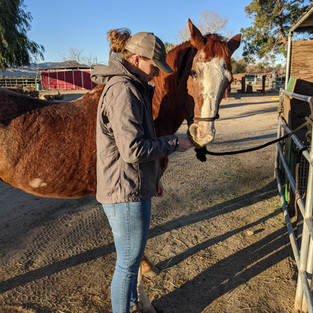Prevent Injury and Improve Mobility With These Simple Stretches
- puresoleproducts
- Dec 31, 2020
- 3 min read
As a bodyworker I am often called in after an injury has occurred to relive tension and pain in the horse. I’ve found if you incorporate a few basic stretches into your horse's routine, you will not only improve range of motion and flexibility, but you will greatly reduce the chance of injury and improve your horse's attitude. Sometimes my clients are surprised when I tell them bodywork and massage will improve their horse's attitude. People will often label a horse as “mean” or “difficult” when the reality is they are reacting to discomfort in their body. Horses are very communicative animals and they typically make it clear in multiple forms of communication when they are uncomfortable. Have you ever gone to groom your horse and your once sweet cuddly buddy all of a sudden pins their ears, twists their tails, and makes every effort possible to throw you away from certain areas? Does your horse resist certain leads? Is it a battle every time you tighten the girth or try to put in a bit? These are typically indicators of pain. If you do not already, I encourage you to take 5 minutes before and after your ride to incorporate these basic stretches into your routine.
Standing in front of your horse, facing his hind, with your shoulder at his neck, place your hand behind his knee and lift his leg up off the ground. As you're bending down to lift the leg, you can gently press your shoulder into your horse’s shoulder to encourage him to unweight the leg you’re asking for. Hold your horse's leg up, your hand under his knee for a few seconds and then release. Repeat on the other side. I also like to do this after I’ve tightened the girth. It stretches the muscles that lie under the girth and prevents them from getting jammed up. This helps release tension on horses who are reactive in the girth area. Make sure when performing this stretch you are keeping the horse's leg in-line with their body.
Ask your horse to bring his leg forward again, this time support the leg under the cannon bone; sometimes it’s easier to hold by the toe of the foot. Extend the leg forward, keeping the knee slightly bent. Hold for a few seconds, release, and repeat on the other side. Make sure when performing this stretch you are keeping the horse’s leg in-line with his body.
Moving to the hind end, pick up the hoof like you are going to clean it. Continuing to hold the hoof, start to slowly, and slowly is the key here, extend the horse's leg out behind him. With this stretch you want to listen to the horse. Only extend the leg as far as the horse will allow; once the horse starts to resist, back off a little until he relaxes again, hold for a few seconds, and repeat on the other side. As you start to learn to read your horses, you can begin to ask them to stretch a little further out each time.
The final stretch is a variation on carrot stretching. Most of the time when people carrot stretch their horse, they stand at the shoulder, present a treat and their horse brings their neck around to get the treat, stretching their neck. This is great in of itself but I find that most tightness occurs in the horse's mid neck and by only standing at the shoulder, you miss engaging the first 2/3 of the neck. The horse pushes right through those areas. I advise my clients to break this stretch into 3 parts. First, stand closer to the horse's head and have them come around, then take a small step back to the mid neck and ask them to come back further, finally end the stretch at their shoulder or further back by their flank/side and ask them to stretch again. Repeat on the other side.
Whether your horse is competing in high level competitions or enjoys casual trail rides with you, bodywork and massage are important components to their overall health, both mentally and physically.

By Erin Quitoriano – Erin specializes in the Masterson Method style of Bodywork and is certified in Sports Massage Therapy and Kinesiology Taping. She is also a Barefoot Trimmer and is a member of the PHCP. (Progressive Hoof Care Practitioner)

















Comments